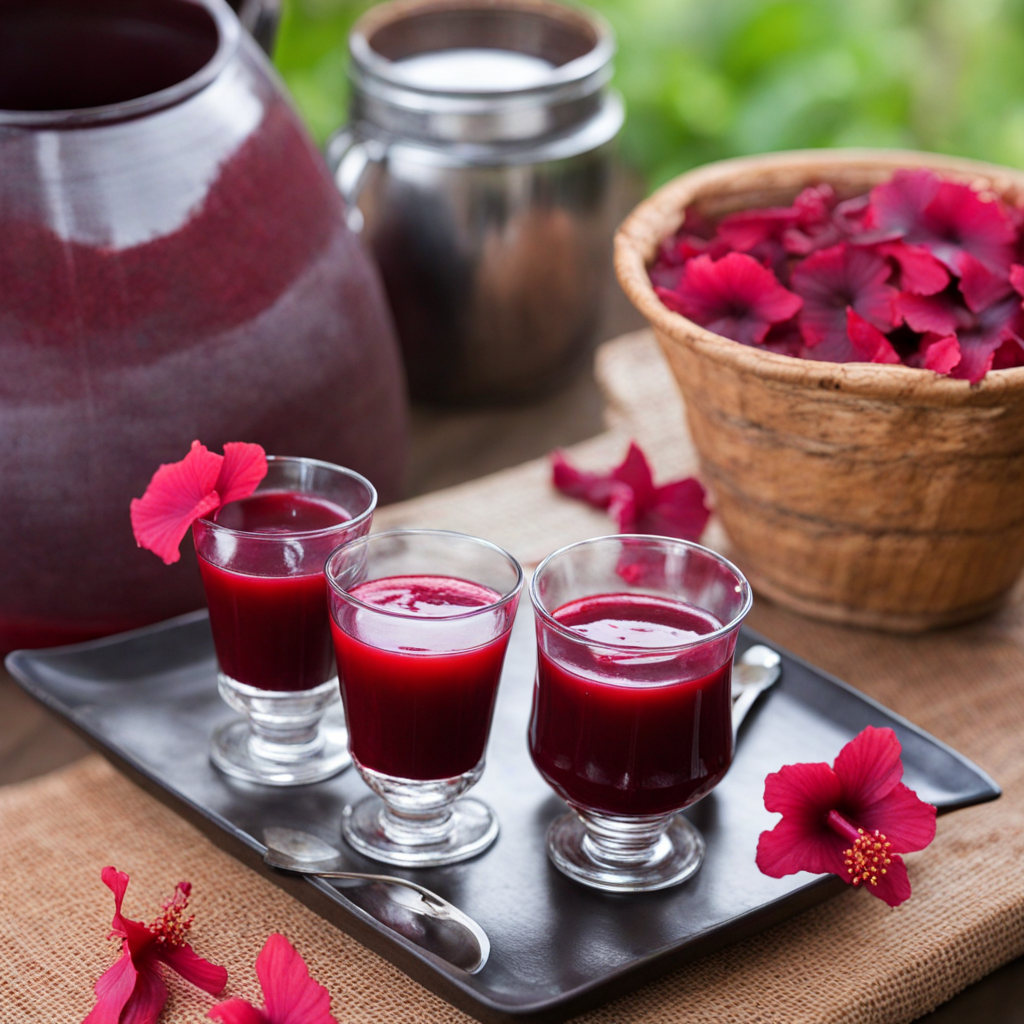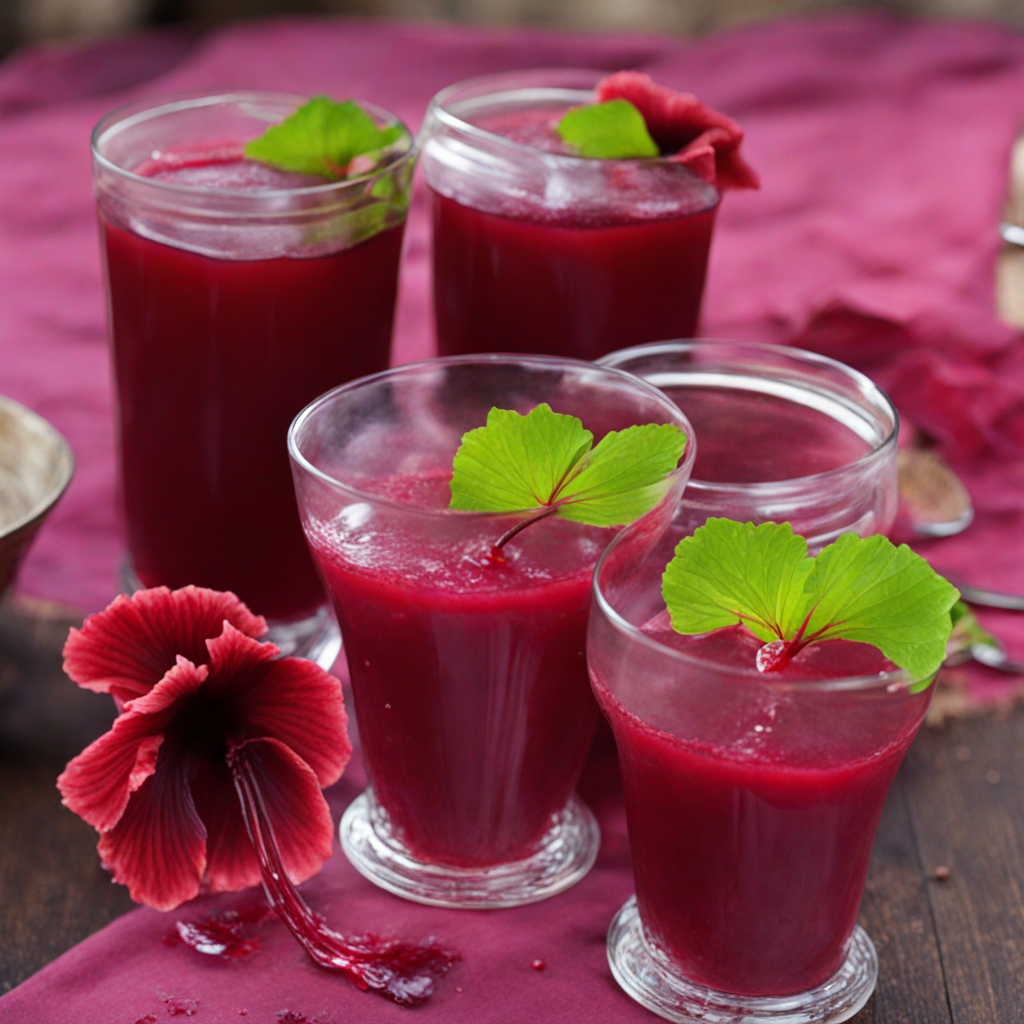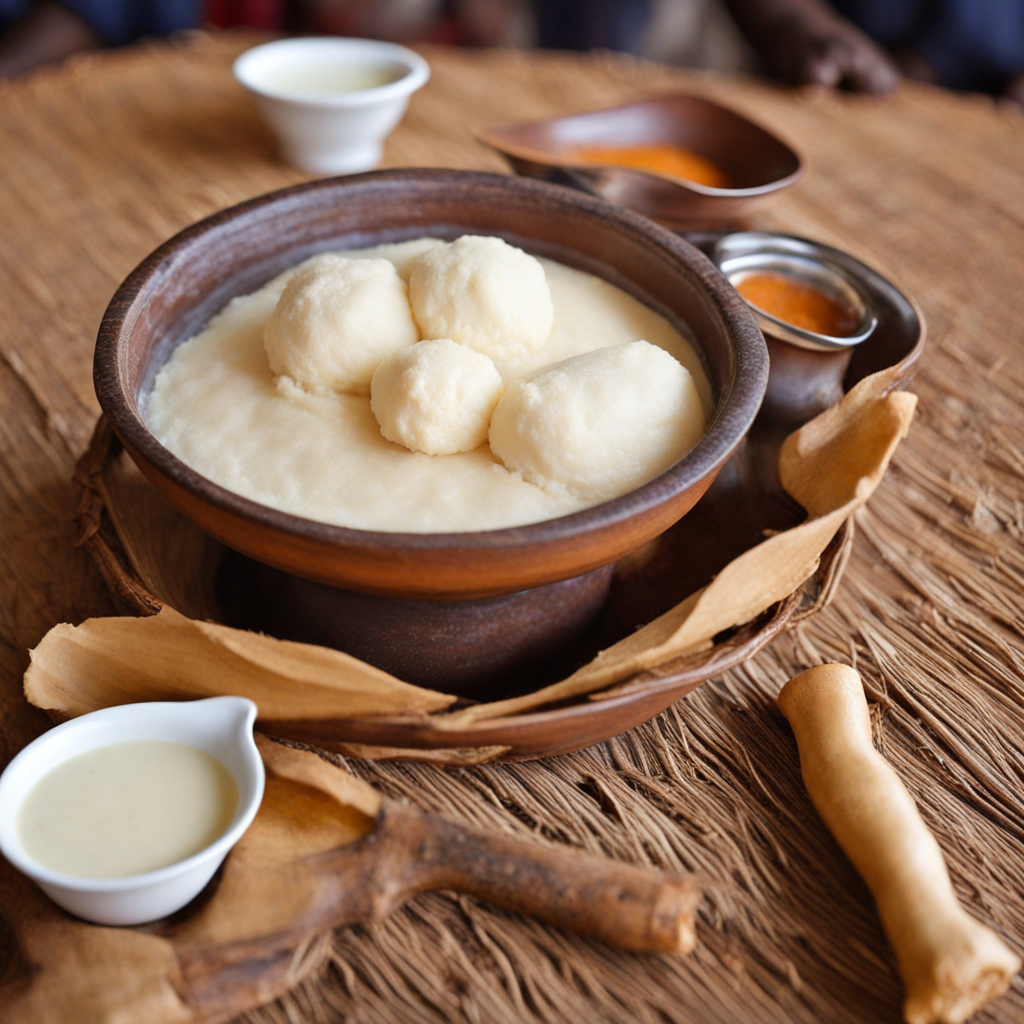Bissap Juice
Bissap Juice, a vibrant and refreshing beverage from Burkina Faso, is derived from the dried hibiscus flowers, known locally as bissap. This striking drink boasts a deep ruby-red hue that is as enticing to the eyes as it is to the palate. The infusion of these petals creates a tart and slightly sweet flavor profile, reminiscent of cranberry or pomegranate, making it a delightful option for those seeking a unique twist on traditional juices. Often enjoyed chilled, Bissap Juice is a favorite during warmer months, providing a thirst-quenching escape from the heat. The preparation of Bissap Juice involves steeping the dried hibiscus flowers in water, allowing the natural flavors and vibrant colors to infuse. To enhance its taste, sugar or honey is commonly added, along with a splash of citrus, such as lime or orange juice, which complements the tartness beautifully. Some variations may include additional spices like ginger or mint, elevating the drink’s complexity and aroma. This versatility allows for personal customization, ensuring each glass can be tailored to individual preferences, whether one enjoys it sweeter or with a zesty kick. Beyond its delightful taste, Bissap Juice is also celebrated for its health benefits. Rich in antioxidants, it is believed to aid in digestion, lower blood pressure, and provide a boost of hydration. As you take your first sip, you'll not only be indulging in a refreshing experience but also embracing a piece of Burkina Faso's rich cultural heritage. Perfect for gatherings or as a personal treat, Bissap Juice is a true testament to the beauty of African flavors waiting to be discovered.
How It Became This Dish
The Refreshing Legacy of Jus de Bissap in Burkina Faso Jus de Bissap, a vibrant and refreshing drink, has become a staple in the culinary landscape of Burkina Faso and several other West African nations. Made from the dried calyces of the hibiscus flower, known scientifically as Hibiscus sabdariffa, this beverage is not just a thirst-quencher; it embodies the rich cultural heritage and social fabric of the region. The history of Jus de Bissap is intertwined with the agricultural practices, social customs, and traditional medicine of the Burkinabé people, showcasing how food and drink can serve as a lens through which to view a community's identity and evolution. #### Origins of Bissap The hibiscus plant, from which Bissap is derived, is believed to have originated in Africa and parts of Asia. Its use dates back centuries, where it was not only appreciated for its culinary applications but also for its medicinal properties. In many African cultures, hibiscus is revered for its health benefits, which include lowering blood pressure, improving digestion, and providing a rich source of antioxidants. While the precise origins of Jus de Bissap are difficult to pinpoint, its roots can be traced back to the regions of West Africa where hibiscus cultivation flourished. In Burkina Faso, the drink is often made with a base of dried hibiscus flowers, sugar, and water, sometimes enhanced with flavors from ingredients like mint or ginger. The preparation method is simple yet effective, involving steeping the dried flowers to release their vibrant color and tangy flavor, a practice that reflects the communal nature of food preparation in many African households. #### Cultural Significance Jus de Bissap holds a significant place in Burkinabé culture. It is more than just a drink; it is a symbol of hospitality and community. Traditionally served at celebrations, family gatherings, and social events, it acts as a bridge between people, fostering connections and creating an atmosphere of warmth and camaraderie. The bright red hue of the drink is often associated with joy and festivity, making it a popular choice during weddings, religious ceremonies, and cultural festivals. In Burkina Faso, the preparation of Jus de Bissap can be a communal affair, involving family and friends who come together to prepare the drink in large quantities. This social aspect of its production emphasizes the importance of community in Burkinabé culture. Sharing a glass of Jus de Bissap is an invitation to engage in conversation, storytelling, and the sharing of experiences, making it an integral part of social bonding. Moreover, Jus de Bissap is often served alongside traditional dishes, complementing the flavor profiles of local cuisine. It pairs well with spicy foods, balancing heat with its sweet and tart notes. This synergy between food and drink highlights the intricate relationship within Burkinabé gastronomy, where each element contributes to a holistic dining experience. #### Development Over Time Over the years, Jus de Bissap has evolved, reflecting changes in society, economy, and culinary trends. The rise of urbanization in Burkina Faso has led to a greater appreciation for street vendors who serve refreshing beverages like Jus de Bissap. These vendors have become an integral part of the urban landscape, providing accessible and affordable refreshments to busy city dwellers. Street-side stalls often feature large glass containers filled with the drink, drawing in customers with their vibrant color and inviting aroma. In recent years, Jus de Bissap has also gained international recognition, finding its way into the culinary offerings of African restaurants around the globe. The drink is often highlighted for its health benefits and unique flavor profile, appealing to a broader audience that values both taste and wellness. This international exposure has sparked interest in traditional African beverages, leading to a revival of interest in other indigenous drinks made from local ingredients. Additionally, the global demand for natural and organic products has prompted many Burkinabé farmers to cultivate hibiscus intentionally. This has not only supported local economies but also ensured the preservation of traditional agricultural practices. The resurgence in hibiscus cultivation has, in turn, sustained Jus de Bissap’s availability and prominence in both local and international markets. #### Contemporary Interpretations In contemporary Burkinabé society, Jus de Bissap continues to be celebrated, but it is also subject to innovation. Modern recipes may incorporate a variety of fruits and herbs, such as pineapple, lemon, or even spices like cinnamon, allowing for a fusion of flavors that cater to younger generations seeking new taste experiences. This adaptability speaks to the resilience of traditional foods, allowing them to thrive in an ever-changing culinary landscape. Moreover, Jus de Bissap has become a symbol of cultural pride, with many Burkinabé people expressing their identity through local cuisine. In a world increasingly dominated by globalization, traditional drinks like Jus de Bissap serve as a reminder of the importance of cultural heritage. Efforts to promote Burkinabé cuisine on international platforms have also highlighted Jus de Bissap as a representative beverage of the nation, contributing to a broader understanding and appreciation of West African food culture. #### Conclusion Jus de Bissap is more than just a drink; it is a testament to the rich cultural heritage of Burkina Faso. Its origins in the hibiscus plant tie it to the agricultural practices of the region, while its role in social gatherings underscores the importance of community and hospitality in Burkinabé culture. As it continues to evolve and adapt to modern tastes and global influences, Jus de Bissap remains a cherished symbol of identity, resilience, and the vibrant culinary traditions of West Africa. Through every sip, one can taste the history, community, and joy that this beloved drink embodies.
You may like
Discover local flavors from Burkina Faso







